
The New River is a river which flows through the U.S. states of North Carolina, Virginia, and West Virginia before joining with the Gauley River to form the Kanawha River at the town of Gauley Bridge, West Virginia. Part of the Ohio River watershed, it is about 360 miles (580 km) long.
Comachara is a monotypic moth genus in the family Noctuidae. Its single species, Comachara cadburyi, or Cadbury's lichen moth, is found in eastern North America, including Alabama, Florida, Georgia, Kentucky, Maryland, New Jersey, New York, North Carolina, Ohio, Pennsylvania, South Carolina, Tennessee, Texas and West Virginia. Both the genus and species were first described by John G. Franclemont in 1939.
Lytrosis is a genus of moths in the family Geometridae first described by George Duryea Hulst in 1896.
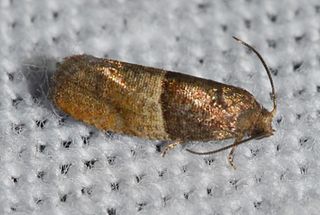
Larisa is a genus of moths belonging to the subfamily Olethreutinae of the family Tortricidae. It contains only one species, Larisa subsolana, which is found in North America, where it has been recorded from Alabama, Florida, Georgia, Illinois, Indiana, Kentucky, Maine, Maryland, Massachusetts, Minnesota, Mississippi, Missouri, New York, Ohio, Oklahoma, Ontario, Quebec, South Carolina, Tennessee, Texas, Virginia, and West Virginia.
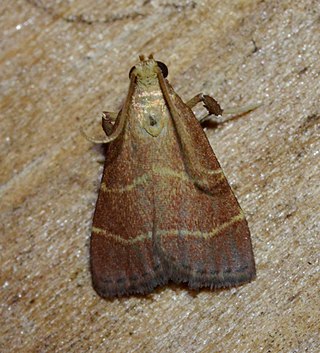
Arta statalis, the posturing arta moth, is a species of snout moth in the genus Arta. It was described by Augustus Radcliffe Grote in 1875 and is the type species of its genus.
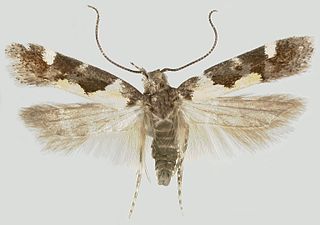
Stegasta bosqueella is a species of moth of the family Gelechiidae. It is found in North America, including Alabama, Florida, Georgia, Illinois, Iowa, North Carolina, Oklahoma, South Carolina, Texas and Virginia.
Clostera inclusa, the angle-lined prominent moth, many-lined prominent or poplar tentmaker, is a moth of the family Notodontidae. The species was first described by Jacob Hübner in 1831. It is found in North America, including Arkansas, Colorado, Florida, Georgia, Illinois, New Hampshire, New York, North Carolina, Oklahoma, Ontario, Oregon, Pennsylvania, South Carolina and Virginia.

Cecrita guttivitta, the saddled prominent moth, is a species of moth of the family Notodontidae. It is found in North America, including Alabama, Arkansas, Connecticut, Delaware, Florida, Georgia, Illinois, Indiana, Iowa, Kansas, Kentucky, Maine, Maryland, Massachusetts, Minnesota, New Brunswick, New Hampshire, New Jersey, New York, North Carolina, Ohio, Oklahoma, Ontario, Pennsylvania, South Carolina, Tennessee, Vermont, Virginia, West Virginia and Wisconsin.
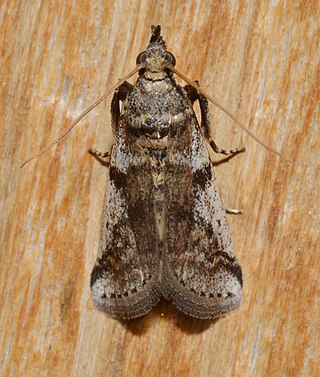
Laetilia coccidivora, the scale-feeding snout moth, is a species of snout moth in the genus Laetilia. It was described by John Henry Comstock in 1879.
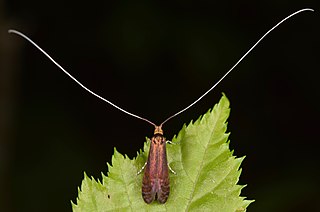
Adela caeruleella, the southern longhorn moth, is a moth of the family Adelidae or fairy longhorn moths. It was described by Francis Walker in 1863. It is found in North America, including Alabama, Arkansas, Florida, Illinois, Kentucky, Louisiana, Maryland, Mississippi, North Carolina, Ohio, Oklahoma, Pennsylvania, South Carolina, Tennessee, Texas, Virginia and West Virginia.

Acrolophus mora, the dark acrolophus, is a moth of the family Acrolophidae. It was described by Augustus Radcliffe Grote in 1881. It is found in North America, including Florida, Georgia, Illinois, Kentucky, Maryland, Massachusetts, Mississippi, New Hampshire, New York, North Carolina, Ohio, Quebec, South Carolina, Tennessee, Virginia and West Virginia.
Schrankia macula, the black-spotted schrankia moth, is a moth of the family Erebidae. The species was first described by Herbert Druce in 1891. It is found from North America to Central America.

Sparganothis xanthoides, the mosaic sparganothis moth, is a species of moth of the family Tortricidae. It is found in most of North America, including Alberta, Arizona, British Columbia, California, Colorado, Connecticut, Idaho, Illinois, Indiana, Kentucky, Maine, Manitoba, Maryland, Massachusetts, Michigan, Nebraska, New Brunswick, New Hampshire, New Jersey, New York, Newfoundland, North Carolina, the Northwest Territory, Nova Scotia, Ohio, Ontario, Oregon, Pennsylvania, Quebec, Saskatchewan, South Carolina, Virginia, Washington, West Virginia, Wisconsin and Wyoming.

Diacme adipaloides, the darker diacme moth, is a moth in the family Crambidae. It was described by Augustus Radcliffe Grote and Coleman Townsend Robinson in 1867. It is found in North America, where it has been recorded from Alabama, Arkansas, Florida, Indiana, Maine, Maryland, Massachusetts, Michigan, Minnesota, New Brunswick, New Hampshire, New Jersey, New York, North Carolina, Nova Scotia, Ohio, Oklahoma, Ontario, Quebec, South Carolina, Tennessee, Texas, Virginia, West Virginia and Wisconsin. Adults have been recorded year round.

Dichorda iridaria, the showy emerald moth, is a moth of the family Geometridae. The species was first described by Achille Guenée in 1857. It is found in North America, where it has been recorded from Alabama, Arkansas, Florida, Georgia, Illinois, Indiana, Iowa, Kentucky, Maryland, Massachusetts, Mississippi, New Hampshire, New Jersey, New York, North Carolina, Ohio, Oklahoma, Ontario, Pennsylvania, Quebec, South Carolina, Tennessee, Texas, Virginia, West Virginia and Wisconsin.
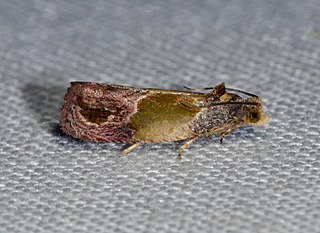
Eumarozia malachitana, the sculptured moth, is a species of moth of the family Tortricidae. It is found in eastern North America, where it has been recorded from Alabama, Arkansas, California, Florida, Georgia, Illinois, Indiana, Iowa, Kentucky, Louisiana, Maine, Maryland, Massachusetts, Minnesota, Mississippi, Missouri, New Jersey, North Carolina, Ohio, Oklahoma, Ontario, Pennsylvania, South Carolina, Tennessee, Texas, Virginia and West Virginia.

Hyperstrotia secta, the black-patched graylet moth, is a moth of the family Erebidae. The species was first described by Augustus Radcliffe Grote in 1879. It is found in North America, where it has been recorded from Alabama, Arkansas, Florida, Georgia, Illinois, Indiana, Kentucky, Louisiana, Maryland, Massachusetts, Mississippi, New Hampshire, New Jersey, New York, North Carolina, Ohio, Oklahoma, South Carolina, Tennessee, Virginia and West Virginia.
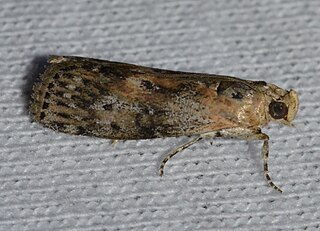
Sciota virgatella, the black-spotted leafroller moth, is a species of snout moth in the genus Sciota. It was described by James Brackenridge Clemens in 1860. It is found in North America, where it has been recorded from Arkansas, Florida, Georgia, Illinois, Indiana, Maine, Maryland, Massachusetts, Minnesota, New Jersey, New York, North Carolina, Ohio, Oklahoma, Ontario, Pennsylvania, Quebec, South Carolina, Tennessee, Texas, Virginia and West Virginia.

Euchlaena deductaria, the forked euchlaena moth, is a species of moth of the family Geometridae. It is found in North America, where it has been recorded from Alabama, Arkansas, Florida, Georgia, Kentucky, Maine, Maryland, New York, North Carolina, Ohio, Oklahoma, South Carolina, Tennessee, Texas and West Virginia.

Metalectra quadrisignata, the four-spotted fungus moth, is a species of moth in the family Erebidae. It is found in North America, where it has been recorded from Arizona, Florida, Georgia, Indiana, Iowa, Kentucky, Louisiana, Maine, Maryland, Massachusetts, Michigan, New Brunswick, New Hampshire, New Jersey, North Carolina, Ohio, Oklahoma, Pennsylvania, Quebec, South Carolina, Tennessee, Texas, Virginia, West Virginia and Wisconsin. The species was described by Francis Walker in 1858.
















